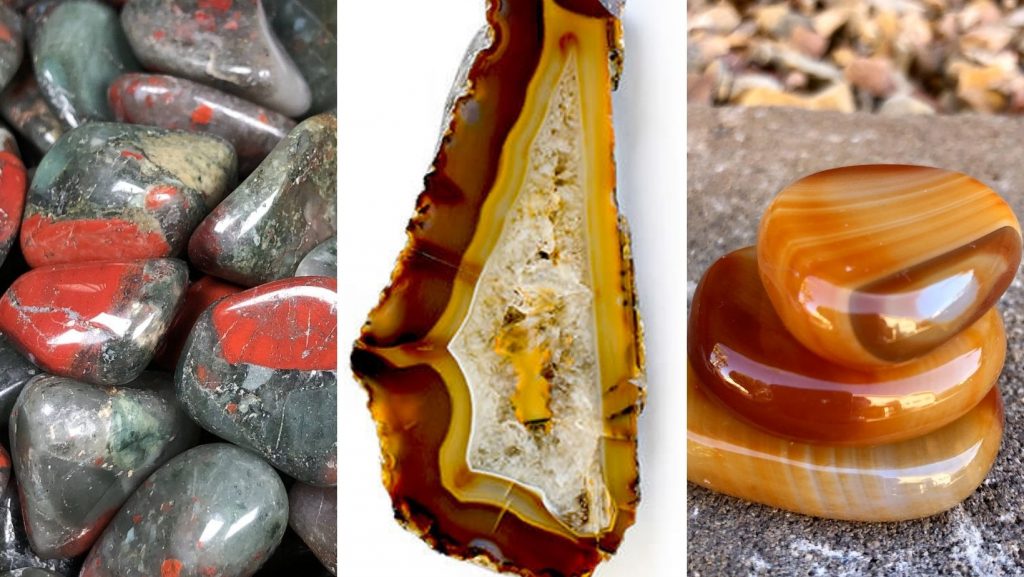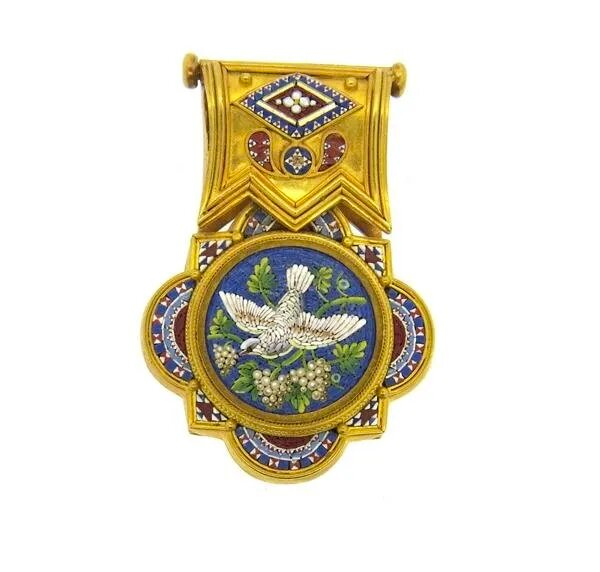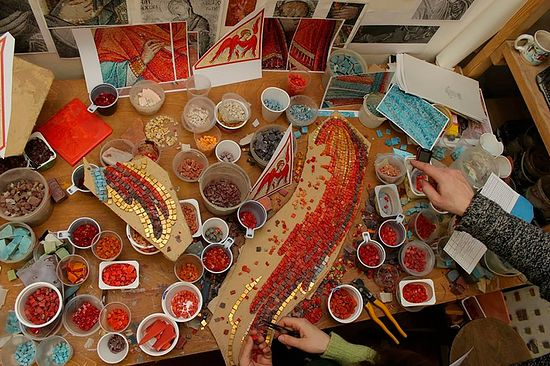Semi-Precious Stones in Mosaic Art

Modern mosaic artwork has become a playground for artists. Using items that range from old CDs to natural objects, they’ve pushed boundaries. We’re taking a look at more materials from the other end of the spectrum: Semi-Precious Stones.
Mosaicists have incorporated gemstones into their work for centuries, providing for a fascinating history. Fortunately for us, there are copious examples of fine mosaic artwork to illustrate how they were used. Break out your jeweler’s loupe – let’s dive into the world of these beauties!
So What Are Semi-Precious Stones, Exactly?

Semi-Precious stones are identified by exclusion. Back in the 1800s, the Big Four of Precious Stones was determined to be Diamonds, Rubies, Sapphires, and Emeralds. Clear, cut in facets, and more valuable by the carat, these are the top gemstones.
That leaves us with – yep, the Semi-Precious stones. Colorful, fancy, and beautiful, they come in a rainbow of colors. There’s a huge array of types – with more named every year. You might have jewelry made from some of these stones. From the earthy colors of Agate and Chalcedony to the intense hues of Amethysts and Lapis Lazuli, they’re familiar and beloved.
Pietra Dura in The Renaissance Era

Image source Metropolitan Museum of Art
Florence Italy in the Middle Ages was Ground Zero for the art of Pietra Dura. Literally “hard rocks”, this lapidary art form was regarded as “painting in stone” by the native Florentines. We can thank the famous Medici family for bringing it to prominence. Francis I was a major proponent and benefactor of the pietra dura style, commissioning pieces, creating a central workshop for artists to hone their craft, and funding their work. Thanks to his sponsorship, they were also able to try all types of gemstones – creating a valuable catalog of work for future artisans.
Work from that time was intricate, time-consuming, and intended for close scrutiny. The addition of stones like Labradorite, Malachite, and Chalcedony imparted richness and was meant to inspire awe in the viewer. Used on objects like tabletops, medallions, cameos, wall plaques, door panels, garden ornaments, fountains, and benches, pietra dura was not only beautiful but also a status symbol.

Image sources Pinterest
Precious Stone Mosaics Around the World
The popularity of pietra dura spread and flourished. Sourcing the raw gemstones, searching for new colors, and building their “palette” was a never-ending task for artists around the world. In the 17th century, it became popular with Mughals in India. If you’re looking for a link between Tuscan aristocrats and the Taj Mahal – look no further. The famous structure is awash with pietra dura ornamentation – although it’s know there as Parchin Kari.

The semi-precious stones were chosen both for their colors and spiritual significance. Carnelian was worn by the Prophet Muhammad, Bloodstone brought rain to the beautiful gardens, and Sard was believed to bring happiness.

Image sources Pinterest
Semi-Precious Stone Use In Other Mediums

It’s amazing how the use of semi-precious stones never loses its appeal. Mosaic artwork has continued to use them long after the 15th century. The 1800s saw a resurgence of the art in its most exacting sense: Micro mosaics. Just like larger mosaic wall art, they’re constructed from tesserae – only on a tiny scale. Utilizing sections of semi-precious stones, they look like minute paintings.
Tightly fitted, the gemstone tiles don’t require grout. They were used as personal jewelry and on many other small items – and were a preferred gift at royal courts. There was also an avid collecting community of travelers who visited Italy on their “Grand Tour” of Europe.

Contemporary Takes on Semi-Precious Stone Mosaic Artwork

Today, semi-precious stones are still a compelling choice in mosaic artwork. Some uses harken back to the traditional: Adding them to impart radiance and meaning to religious art, for example. At the St. Elisabeth Monastery in Minsk, the monk artists feel that they are “co-creating with God” on every project. As they source the stones and work on the designs, the materials and mediums are subject to mystical inspiration. Stones like Turquoise, Amber, and Jasper often appear amongst the shining glass mosaic tiles.


Image sources Pinterest
Elsewhere, semi-precious gemstones are used in contemporary mosaic artwork to great effect. Although the range of mosaic tile colors is extensive, the richness of these stones is hard to reproduce.
Just like the pietra dura pieces from centuries prior, they add a new dimension to the art: inviting the viewer to take a closer look. This contemporary piece incorporates not only traditional glass mosaic tiles, but also semi-precious stones. The artist, Genaro Alvarez, was an outstanding muralist in the Mexican Modern tradition. Adding these stones to his pieces was a trademark.

Image source liveauctioneers.com
Artist duo Sandra and Carl Bryant use semi-precious stones to illuminate sections of their mosaic artwork. You’ll see a whole range of finishes and stone types in their recent work “Night Music”.

Susan Nanna Casbarro’s works often feature small-scale flowers and plants. Her mix of glass mosaic tiles and uncut precious gemstones adds a bit of humor to her botanical subjects.

Susan Wechsler is a mosaic artist who creates works with mixed media that often includes semi-precious stones. Her pieces take on different facets of meaning – with the long-distance view sometimes echoing the smaller components. Pieces like her “Bursting Into Life” are packed with found objects and carefully chosen elements like gemstones.

Image source MosaicsbySusan.com
In contrast to some of the mannerly pieces we’ve shown, her work is bursting with the rawness of nature and unprocessed gemstones.
Ready to Try Semi-Precious Gems?
If you’re inspired to try adding semi-precious stones to your own mosaic projects, you’ll be amazed at the types and colors of gems that are available to you.

You’re sure to become immersed in all the names, origins, and color variations of today’s semi-precious stone offerings. They’re just as desirable today as always. They can be added as stand-alone elements in your personal artworks.
Or, are you hankering for the glint of gemstones in your purchased mosaic artwork? What would you like to see in your own home? Luscious Lapis Lazuli? Serenely blue Sodalite? One of the many types of Jasper? Let us know in the comments!
Be sure to visit our website for our newest designs – and don’t forget to subscribe to our newsletter!










